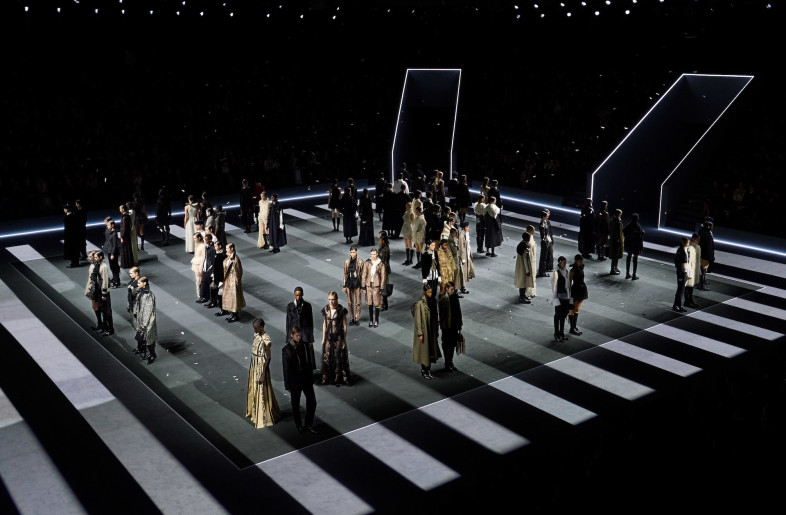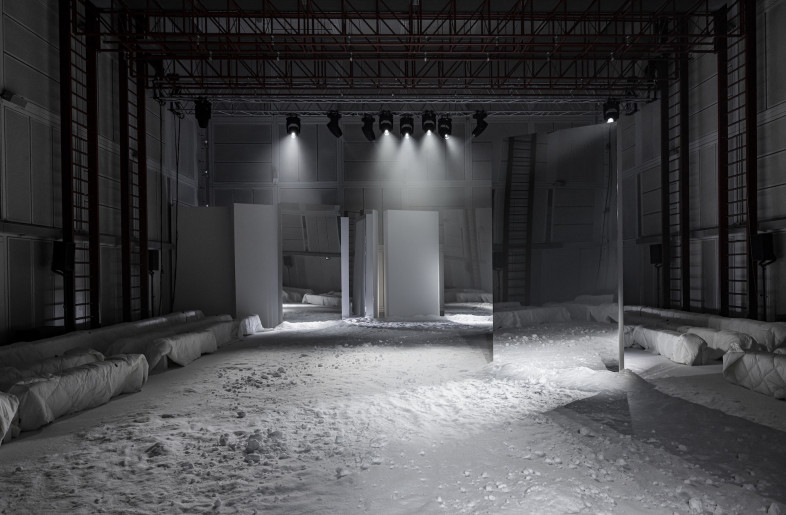Maiko Takeda sculpts ethereal silhouettes with eye-catching forms. Her designs succinctly combine material clarity with a surreal sense of transformation, as seen recently in the artwork for the digital release of Björk's new Vulnicura album. Takeda's creations will also soon grace the front of Frame's forthcoming book Postdigital Artisans and we caught up with the artist to discover more about her craft.
Currently based in Tokyo, Takeda's interests lie in conjuring an experience of wonder with her bodily adornments. Carefully constructed from ordinary materials, these are much more than headpieces; enveloping the wearer’s frame in a holographic sheen. 'I'm interested in anything that surrounds us, but is hard to perceive; which almost hangs between existing and not existing,' explains Takeda. Trained in jewellery design and millinery, her pieces combine aspects of both trades and are made with finely-cut strips of acetate affixed to a contemporary chainmail base. Emanating a glorious glow, the pieces can be seen as a type of body armour, maybe of an exotic creature from another planet or from a deep underworld where the currents gently sway the colour-tipped fringes.
This unique visual landscape was developed during the designer’s studies at the Royal College of Art in London in 2013. For her MA in millinery, her thesis project was entitled Atmospheric Reentry and was largely inspired by an opera by Philip Glass and its formalist approach based on structured spaces.
------------------
Can you describe your process?
I prefer to work with three-dimensional materials rather than drawing on paper, so my desk is surrounded by lots of materials and paper prototypes, etc. My process often starts with an abstract question, such as 'How would it feel to wear a cloud?' or 'How can a shadow be worn as jewellery?' Then I collect various materials to experiment with until I find a technique that achieves the visual effect I want. Once the technique is established, I start building parts around the body to decide on the silhouettes and finalise the designs.
Does this differ from piece to piece and for specific commissions?
Depending on the time frame I have, but sometimes I follow a more spontaneous and intuitive process too. For instance, when I work on specific commissions often there are already themes or materials to work with so I can start experimenting with materials and see what happens. I also enjoy this way of working as it frees me up from thinking too much.
How did your training in jewellery design and millinery prepare you for what you are doing now?
Both specialisms require different skill sets and deal with different materials, so it's great to be able to cross over and combine different elements in my work. For example, the Atmospheric Reentry collection pieces are made of plastic units that are linked with tiny silver rings. It is all handcrafted; there's nothing digital about it – it's made through completely analogue processes.
Do you consider the pieces that you make to be artworks or fashion?
Both. I love to take time to develop a concept and create handcrafted pieces; however, on the other hand as long as my pieces are made for the body, I would like them to be fashion as well. As a fashion item, it needs to be functional and simply desirable as a product, and it is for me an important element that pushes my creativity. My designs are made to be worn, and act as mediators between the wearer and their environment.
For your MA collection, what inspired you to first create such a visual landscape around the body?
Initially I started with a question about how it might feel like to wear a cloud, which led me to think about a headpiece with blurred boundaries to its surrounding space so that no one can tell where it starts and where it ends. Around the same time, I saw the Philip Glass opera Einstein on the Beach during its revival tour in 2012. It was such a mind-blowing experience that I became obsessed with its futuristic sounds and imagery. That experience heavily inspired the aesthetic of the collection.
You create highly material forms. Do you have a favourite material you like to work with?
My work may appear to have digital and high-tech aesthetic; however, it is actually made of ordinary and available materials, such as sheets of acetate, laser-cut acrylic discs and silver rings. I also love to use unusual materials but my interest is to create otherworldly and surreal experiences through my work that are made of physical and real materials.
How did the recent commission for the recent Björk album cover develop?
It was a spontaneous process. They told me about their inspiration and I sent over some pieces for them to play with and improvise to create the look.* I love the image and feel extremely honoured to be able to collaborate with her again. The first collaboration I had with Björk was during her Biopholia tour in 2013 when she wore my headpieces on several stages around the world.
(*Note from the editor: The album cover sees Björk in an outfit of her own creation, featuring Takeda's headpiece and jewellery by Staskauskas, shot by the photographic duo Inez Van Lamsweerde and Vinoodh Matadin.)
------------------
Maiko Takeda's work will feature in Postdigital Artisans – Craftmanship With a New Aesthetic in Fashion, Art, Design and Architecture. This book, by author Jonathan Openshaw, focuses on a return to tactility, featuring contemporary artisans who craft objects by hand whilst embracing the digital age. For more information on this book, and to buy your copy, go here.




-thumb.jpg)





